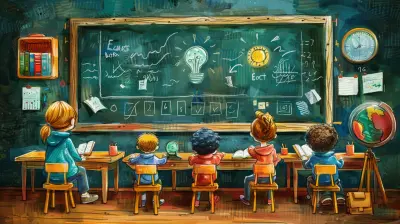How to Use Visual Aids to Improve Student Understanding
7 October 2025
If you've ever sat through a presentation or a class where the speaker drones on without breaking it up with any visuals, you know just how hard it can be to follow along—let alone remember what was said. Now imagine you’re a student sitting through multiple classes like that. It’s no surprise that sometimes, things just don’t stick. But that’s where visual aids come in. They can be total game-changers when it comes to helping students understand and retain information.
In this article, we’re diving deep into how to use visual aids effectively in the classroom to boost student comprehension. Whether you're a seasoned teacher, a new educator, or even tutoring part-time, these tips are practical, easy to implement, and extremely effective.
Why Visual Aids Matter in Education
Let’s face it—our brains love visuals. In fact, research shows that people remember up to 65% of information three days later when it’s paired with a relevant image, compared to only 10% when they hear it verbally. That’s huge!Visual aids don’t just make learning more engaging; they actually help clarify complex concepts, especially for visual learners. You know, the ones who zone out during a lecture but light up when you show them a diagram? Yeah, those students thrive when visuals are involved.
It’s kind of like trying to cook a dish with just the recipe versus having a video showing each step. The latter makes it easier, right? That’s what visual aids do for learning.
Types of Visual Aids You Can Use
Before we jump into how to use them, let’s talk about the different kinds of visual aids out there. You don't have to rely only on posters or slide decks—in fact, mixing things up is the key to success.1. Charts and Graphs
Perfect for showing data, trends, comparisons, and processes. Bar charts, pie charts, line graphs—you name it. Just don’t make them too cluttered.2. Diagrams and Infographics
Whether it’s the water cycle, human anatomy, or a timeline of World War II, diagrams help students visualize relationships and processes.3. Videos and Animations
Got a concept that’s too abstract to explain in words? A short video can bring it to life. Think science experiments, historical reenactments, or even animated math problems.4. Maps and Globes
Geography class without maps? That’s like peanut butter without jelly. Students need visual references for places, spatial relationships, and demographic data.5. Flashcards and Cue Cards
Especially useful for younger students or for vocabulary-heavy subjects like languages or biology.6. Mind Maps and Concept Maps
Help organize thoughts and show connections between ideas. Great for brainstorming or summarizing lessons.7. Slide Presentations
Slideshows can be powerful if used right—keep text minimal, use high-quality images, and don’t read off the slides (you’re not a robot!).
When and How to Use Visual Aids in the Classroom
Using visual aids isn’t about throwing a few pictures onto a whiteboard and calling it a day. It’s about integrating visuals into your teaching strategy so they actually enhance learning.1. Start With the Learning Objective
Ask yourself: what’s the takeaway you want your students to remember? Choose visuals that directly support this. A random image might be fun, but if it doesn’t reinforce the lesson, skip it.2. Keep It Simple
Complex visuals can confuse more than they clarify. You want your images to complement the lesson, not compete with it. If a diagram looks like a NASA blueprint, tone it down.3. Make It Interactive
Don’t just show a chart—ask your students to interpret what they see. Pause a video and discuss what’s happening. Hand out printed infographics and let students annotate them.4. Use Color Purposefully
Color coding isn’t just pretty—it’s powerful. Use it to show categories, highlight key points, or draw attention to similarities/differences.5. Incorporate Technology
Interactive whiteboards, virtual reality, educational apps—don’t be afraid to get techy. These tools can bring abstract ideas into the real (or virtual) world. Just make sure the tech serves the teaching, not the other way around.
Adapting Visual Aids for Different Learners
Not every student learns the same way. Visual aids can be tailored to support different learning styles, abilities, and age groups.1. For Visual Learners
This one’s a no-brainer. Visual learners soak up information through images, charts, and videos. Give them what they crave!2. For Auditory Learners
Combine visuals with guided explanations, and include subtitles in videos to help them connect spoken words with visuals.3. For Kinesthetic Learners
Get students involved—have them create mind maps, build models, or manipulate objects like puzzle pieces or flashcards.4. For Students with Learning Disabilities
Use visuals to break down instructions into manageable steps. Pictures can offer clarity where verbal instructions might confuse.5. For ESL (English as a Second Language) Students
Visuals are a lifeline. Use pictures, labeled diagrams, and videos to bridge language gaps and build vocabulary.Common Mistakes to Avoid with Visual Aids
Visuals are powerful—when used right. But if misused, they can become distractions or confusion factories.1. Overloading the Visual
Too many elements in one graphic? Your students won’t know where to look. Stick to one concept per visual when possible.2. Ignoring Accessibility
Remember colorblind students or those with visual impairments. Use high contrast, readable fonts, and consider providing verbal descriptions.3. Using Low-Quality Images
Blurry or pixelated images scream, “I made this in five minutes.” Take the time to use high-quality visuals. They’re more engaging and easier to understand.4. Not Explaining The Visual
Dropping a chart into your slide deck without context is like telling a joke without a punchline. Always guide your students through what they're looking at.Creative Ideas for Using Visual Aids
Ready to take things to the next level? Here are some creative ways to bring visuals into your teaching practice.1. Create a Visual Wall
Dedicate a classroom wall for visual summaries of what you’ve covered. Switch it up each week. Let students contribute, too!2. Use Storyboards
Let students map out historical events, plotlines, or scientific processes in storyboard format. It’s like comic strips for learning.3. Digital Portfolios
Encourage students to build digital portfolios with infographics, diagrams, and annotated visuals they've created themselves.4. Visual Exit Tickets
Instead of written reflections, ask students to draw or annotate a concept that stood out in the lesson. It’s faster, more fun, and just as telling.5. Gamify With Flashcards
Use apps like Quizlet or go old-school and create your own. Visual flashcards make review time engaging and effective.The Long-Term Benefits of Visual Aids
When students engage with visual content, they’re not just memorizing—they’re learning how to think, analyze, and apply concepts. Visual aids support:- Better comprehension
- Long-term retention
- Greater engagement
- Improved test performance
- Stronger critical thinking skills
And let’s be honest—learning becomes a lot more enjoyable when you’re not staring at walls of text all day.
Final Thoughts
So, how do you use visual aids to improve student understanding? Keep it simple, make it relevant, and most importantly—have fun with it. You don’t need to be a graphic designer or video editor. Even the most basic visuals, when used thoughtfully, can turn confusing lessons into moments of clarity.Think of visual aids as your sidekick in the classroom. You’re the superhero with the knowledge, but your visuals help you deliver it with impact. So go ahead and start adding some color, creativity, and clarity into your lessons—and watch your students thrive.
all images in this post were generated using AI tools
Category:
Teacher ResourcesAuthor:

Olivia Chapman
Discussion
rate this article
1 comments
Meagan Wallace
Great insights on utilizing visual aids! They truly enhance comprehension and engagement in the classroom. Simple graphics and interactive visuals can make complex information more accessible for all students.
October 12, 2025 at 11:47 AM

Olivia Chapman
Thank you! I'm glad you found the insights valuable. Visual aids can indeed transform learning by making information clearer and more engaging.


